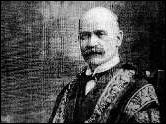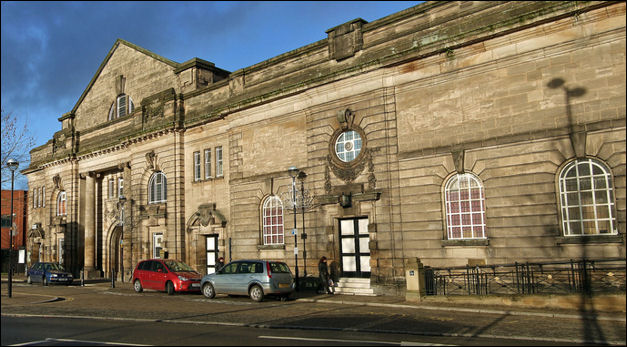|
Historian Fred Hughes writes....
The most
important seat in Stoke-on-Trent’s council chamber is the first one to the
right facing the Lord Mayor. It is the seat normally occupied by the
leader of the council. And in recent times it belonged to such civic
titans as Ted Smith, Ron Southern, Jim Westwood, Arthur Cholerton and Sir
Albert Bennett. It was where Fred Geen sat on 28th January 1915
when he rose to answer an accusation of dishonesty. Geen, sporting an
Edwardian moustache, an accountant and a man of principles higher than his
high-wing collars, stared fixedly at his accusers. As he waved an arm in a
gesture of dismissal, he promptly dropped down dead at the age of
fifty-seven. Such is the burden of responsibility that our elected
representatives carry.

Frederick Geen
“Geen
came to politics through chartered accountancy,” says Potteries’
historian Steve Birks. “Having built up a successful business, which
still thrives in Liverpool Road, he came to prominence when he
successfully challenged the stranglehold of Stoke’s auditors in a
year-long campaign of frenetic politicking. From then on he was never
out of civic limelight, whether overseeing the completion of the Kings
Hall or entertaining royalty at his fine mansion called Cliffe Ville.
There’s no doubt Frederick Geen was a top politician.”
In
the dying years of the Victorian age Geen represented the business
ratepayers of Stoke town who were infuriated over harsh levies the
council applied to their properties.
At
the annual meeting of the borough auditors in 1898 Geen, as mayor,
launched his daring bid to unseat the town executive who happened to
be his trading competitors John Broady and George Herbert Stringer,
accountants who had been returned unopposed since the borough of
Stoke-upon-Trent had been incorporated in 1874.
“John Broady was the son of a brewer’s agent who later took over his
father’s civic responsibilities,” Steve continues.
“His partnership with George Herbert Stringer, the principal
accountant to the North Staffs Railway Company, sealed Stoke’s
monopoly over rail communication for the best part of two decades.
Together these two men controlled the town’s financial
administration until Fred Geen decided otherwise. His success
generally breathed some fresh air through the smoky streets of Stoke
and he was elected to the office of mayor for the borough three
times, 1897, 1899 and 1903 on the strength of his popularity.
Geen though was a committed anti full-federationist, preferring a
civic partnership with Stoke, Fenton and Longton instead. But his
early proposals fizzled out through lack of support.”
|
The
federation of the Potteries’ towns had been an issue for many decades.
In an informative summary in the appendix of People of the Potteries
published by Keele University in 1985, researcher Reg Edwards traces the
first attempts back to 1835. He writes that Stoke-on-Trent MP, John
Davenport of Burslem, strongly recommended a single Potteries’ county
borough, but failed to convince his fellow Boslemites. Even then, it
seems, people chose parochialism rather than unity.
“From
1850 federation schemes came up regularly,” says Steve. “It was a
complicated progression blighted by arguments over different town
ratings and ownership of assets such as sewage and water with each town
fighting its own corner. It became very messy which may have been the
reason that the commissioners favoured Frederick Geen’s new proposals.”
According
to Edwards, Geen’s new plan laid out solutions for the phasing-in of each
town’s ratings over 20 years during which time the fixed assets of each
town would remain in individual liability. Geen desperately wanted Stoke
to be the administrative centre, but Hanley spiked his plan with
alternative proposals while Burslem simply sulked in silence.
“Records show that in 1896 Geen had offices in Glebe Buildings,” says
historian Richard Talbot. “These were at the entrance of Kingsway so he
was in close proximity with the town hall. His home was also in a
prominent place above the Catholic Church overlooking the valley and
town. The house was built by John Tomlinson (1772-1838) in 1808, an
important Stoke solicitor who succeeded in getting Stoke Rectory placed
on statute. It was a superb mansion with extensive gardens, country
walks and tennis courts. It became Geen's palace where, in 1913, he
entertained King George V and Queen Mary after they’d formally opened
the Kings Hall. In 1922 the estate was acquired by local nuns for the
Dominican Convent and was central to St. Dominic's High School before
being demolished in 1988. The land now is occupied by Tolkien Way
residential district.”
Geen’s
business partner was Frederick William Carder. Among their clients were
many famous potters as well as Stoke City FC.

Kings Hall, Stoke
“After
federation in 1910 Geen left Carder in full control and immersed himself
in civic duty driving the infant authority to new heights,” says Steve.
“Geen became the second mayor of the new federated borough from 1911 to
1913 after Cecil Wedgwood. Some say he alone created Stoke town hall as
the centre of administration. But there’s no question that he facilitated
the design of the impressive council chamber. What magnificent irony then
to die in the place of your greatest achievements.”
 more on Frederick Geen
more on Frederick Geen
 see the battle for the federation town hall
see the battle for the federation town hall

click the "contents"
button to get back to the main index
|
